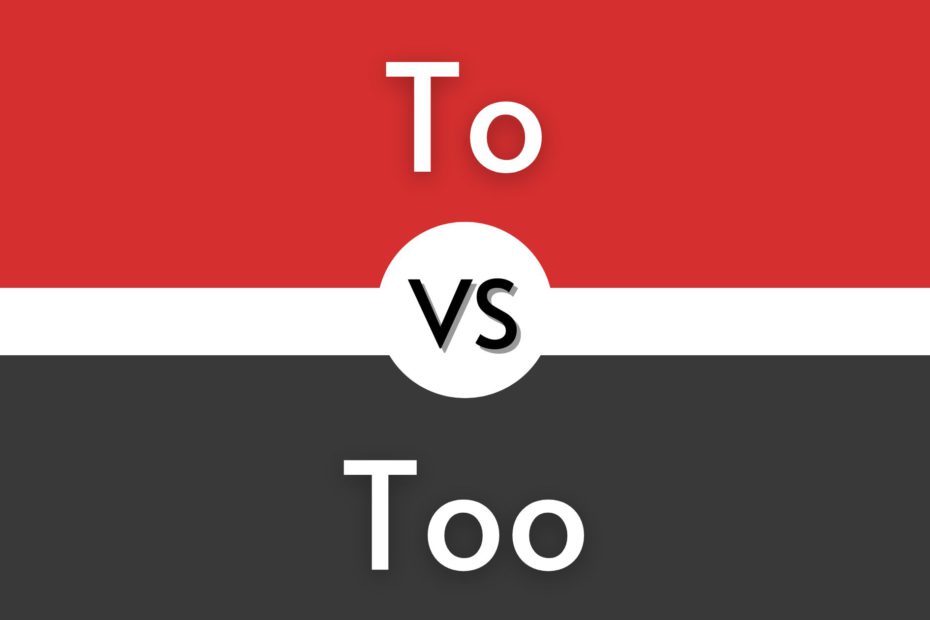“To” and “Too” are both commonly used English words, but they have different meanings. “To” is used as a preposition, whereas “too” is an adverb. It can be tricky to know when to use “to” and when to use “too”. In this article, I will show the difference between To and Too. Stay here!
To and too is a question that many people have. To is a preposition that shows direction, location, or time. It can also be used as an adverb to show extent or degree. Too is an adverb that means excessively or also. It can also be used to mean very or extremely.
What is the difference between “To” and “Too”?
The main difference is that “too” is an adverb, and “to” is a preposition or a verb. This means that “too” will usually come before an adjective or another adverb, modifying it, whereas “to” will usually come before a noun or pronoun, creating a relationship between two things.
Examples of TO and Too:
- I went to the store. (to introduce the infinitive verb went)
- We’re going to have a party. (to introduce the infinitive verb have)
- I’m too tired to go out. (too modifies the adjective tired)
- She’s too lazy to clean her room. (too modifies the adjective lazy)
There is often confusion about when to use the words to and too. When deciding which word to use, see if you can replace the word with excessively. If so, then “too” is the correct word. If not, then to is the correct word.
When to use “To”
The word ‘To’ can be used as a preposition in English to indicate movement toward a particular goal. For example, “I am going to the store.” Here, “to” indicates that the speaker is moving from their current location to the store. “To” can also be used to indicate the recipient of an action, as in “I gave the book to her.” In this case, “to” indicates that the book went from the speaker to the person they gave it. Finally, “to” can be used to express a time or date, as in “We will be leaving at six o’clock tonight.” Here, “to” indicates when the speaker will be leaving.
Examples:
- She went to the store.
- I’ll have to investigate it.
- He informed me to fill in the form.
- Can you tell me where to go?
- To be honest, I don’t like this place.
- He traveled to London last year.
- I gave it to my sister.
To as an infinitive
‘To’ is one of the most versatile words in the English language. It can be used as a preposition, an adverb, or even conjunction. However, its most common usage is as an infinitive. An infinitive is the basic form of a verb, typically preceded by “to,” that expresses an action or a state of being. For example, the infinitive form of the verb “walk” is “to walk.”
When used as an infinitive, it can have a variety of different functions. It can express purpose, as in “I went to the store to buy some milk.” It can also express direction, as in “He walked to the door.”
- I went to the store. (to introduce the infinitive verb went)
- We’re going to have a party. (to introduce the infinitive verb have)
- I want to learn to play the guitar. (infinitive)
Hopefully, this clears things up a bit. Just remember that if you’re not
When to use “Too”
The word ‘too’ is used to show that something is excessive or more than is necessary. For example, if you say ‘I have too much work to do’, you mean that you have more work than you can cope with. If you say ‘That dress is too expensive, you mean that the dress costs more money than is reasonable. The word ‘too’ can also be used to show that something is not as good as it should be. For example, if you say ‘This coffee is too hot, you mean that it is not as cool as it should be.
There are many instances when it is appropriate to use too. For example, if you are overemphasizing a point, you would use too. Another instance is when you are listing a series of items and you want to indicate that there are more than what is listed, you would use too. Additionally, if you want to show that something is excessive or not enough, you would use “too”. In short, too has many uses and is a versatile word.
Examples:
- I have too many clothes to fit in my closet.
- They went too fast.
- I have too much homework to do.
- That movie was too scary for me.
- You’re talking too loud.
- Too much work can be stressful.
To vs Too: The Difference in Formality
To and too are both commonly used in English, but they cannot always be used interchangeably. When deciding which word to use, it is important to consider the context and the formality of the situation. To is more formal than too and is always used before a verb, while too is less formal and can be used either before or after a verb.
To vs Too: How to Remember the Difference
One way to keep “to” and “too” straight is to think about what each word represents. “To” is a preposition that shows direction or a relationship between two things. It can also be used as an adverb or verb. “Too” is an adverb that means “also” or “excessively”. It can also be used as a noun or adjective.
When you’re trying to decide which word to use, think about whether you need a preposition or adverb. If you need a preposition, use “to”. If you need an adverb, use “too”. For example, if you want to say that someone is going in the direction of something, you would use “to”.
Conclusion
“To” and “Too” are entirely different things with different meanings. When deciding which word to use, it is important to first identify the function of the word in the sentence.
If the word is being used as a preposition, it will usually be followed by a noun or pronoun. For example, “I am going to the store.” In this sentence, “to” is showing direction. When used as a preposition, It can also be used to indicate a recipient, as in “I gave the book to my sister. ‘Too’ generally has a negative connotation and indicates excessiveness, as in “There are too many people

